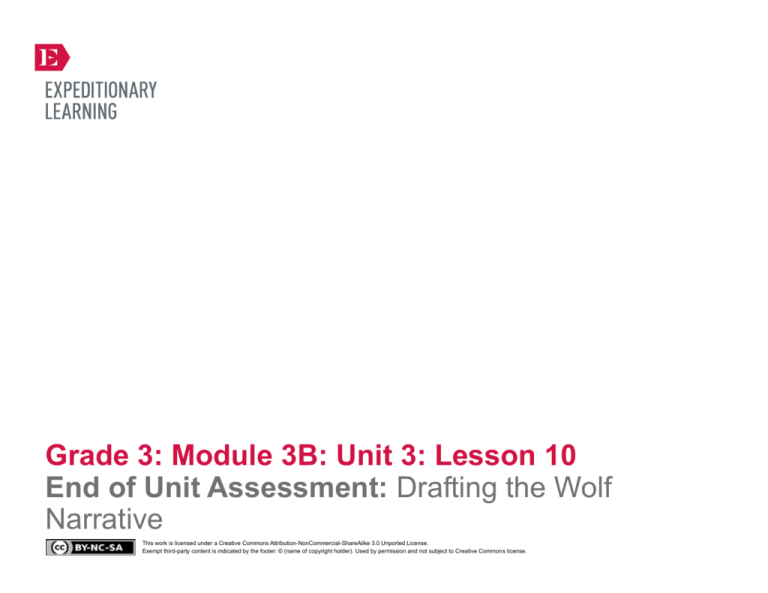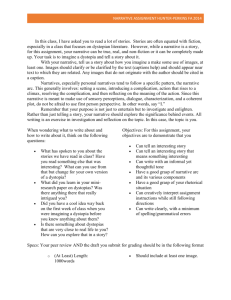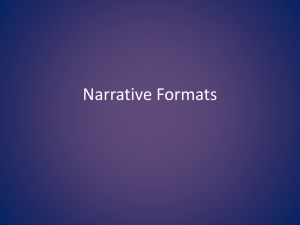
Grade 3: Module 3B: Unit 3: Lesson 10
End of Unit Assessment: Drafting the Wolf
Narrative
This work is licensed under a Creative Commons Attribution-NonCommercial-ShareAlike 3.0 Unported License.
Exempt third-party content is indicated by the footer: © (name of copyright holder). Used by permission and not subject to Creative Commons license.
GRADE 3: MODULE 3B: UNIT 3: LESSON 10
End of Unit Assessment:
Drafting the Wolf Narrative
Long-Term Targets Addressed (Based on NYSP12 ELA CCLS)
I can craft narrative texts about real or imagined experiences or events. (W.3.3)
a. I can establish a situation.
a. I can introduce the narrator and/or characters of my narrative.
a. I can organize events in an order that makes sense in my narrative.
a. I can use dialogue to show the actions, thoughts, and feelings of my characters.
b. I can use descriptive words to show the actions, thoughts, and feelings of my characters.
c. I can use transitional words and expressions to show passage of time in a narrative text.
d. I can write a conclusion to my narrative.
Supporting Learning Targets
Ongoing Assessment
• I can use temporal words and phrases to show the sequence of events in my Wolf Narrative.
• End of Unit 3 Assessment: Wolf Narrative draft
• I can draft a narrative about a problem encountered by wolves using details and descriptions about real
wolves from Face to Face with Wolves.
Created by Expeditionary Learning, on behalf of Public Consulting Group, Inc.
© Public Consulting Group, Inc., with a perpetual license granted to Expeditionary Learning Outward Bound, Inc.
NYS Common Core ELA Curriculum • G3:M3B:U3:L10 • June 2014 • 1
GRADE 3: MODULE 3B: UNIT 3: LESSON 10
End of Unit Assessment:
Drafting the Wolf Narrative
Agenda
Teaching Notes
1. Opening
• In this lesson, students write drafts of their Wolf Narratives for the End of Unit 3 Assessment. Some
students may require more time than the 30 minutes allocated to finish writing the narrative, so you
may need to adjust the time accordingly.
A. Unpacking Learning Targets and Receiving
Feedback (10 minutes)
2. Work Time
A. Analyzing the Wolf Narrative Model: Temporal
Words and Phrases (15 minutes)
B. Drafting the Wolf Narrative (30 minutes)
3. Closing and Assessment
A. Paragraph Share (5 minutes)
4. Homework
A. Continue reading your independent reading book.
• In order to address W.3.3c, before they write students look at a list of temporal words and phrases and
then analyze the Wolf Narrative model to determine when they have been used and why.
• At the end of the lesson, collect students’ End of Unit 3 Assessments to provide feedback. Use the
Narrative Writing Rubric, specifically the criteria in the Organization section to assess student drafts. Be
prepared to return assessments with feedback against the Organization section of the rubric in Lesson
13.
• Note that in the next lesson students will need their Wolf Narrative drafts to revise. You can either
return the drafts (without feedback) for the duration of the next lesson or copy the completed drafts for
students to work from until you have assessed their work.
• In advance:
– Review Mix and Mingle in Checking for Understanding techniques (see Appendix ).
– Ensure you have provided feedback on students’ Mid-Unit 3 Assessments (from Lesson 8).
– Post: Learning targets; Criteria of a Strong Narrative anchor chart.
Created by Expeditionary Learning, on behalf of Public Consulting Group, Inc.
© Public Consulting Group, Inc., with a perpetual license granted to Expeditionary Learning Outward Bound, Inc.
NYS Common Core ELA Curriculum • G3:M3B:U3:L10 • June 2014 • 2
GRADE 3: MODULE 3B: UNIT 3: LESSON 10
End of Unit Assessment:
Drafting the Wolf Narrative
Lesson Vocabulary
Materials
temporal
• Mid-Unit 3 Assessment: Revising Wolf Narrative plans (from Lesson 8; returned in this lesson with teacher feedback)
• End of Unit 3 Assessment: Drafting the Wolf Narrative (one per student and one to display)
• Narrative Writing Rubric (from Lesson 1; one to display)
• Criteria of a Strong Narrative anchor chart (begun in Lesson 1; one to display)
• Examples of Temporal Words and Phrases (one per student and one to display)
• Wolf Narrative model (from Unit 2, Lesson 1; one per student)
• Criteria of a Strong Narrative note-catcher (from Lesson 1; one per student)
• Wolf Character Profile graphic organizer: Parts 1 and 2 (from Lessons 2 and 3; one per student)
• Narrative Elements graphic organizer (from Lesson 5; one per student)
• Face to Face With Wolves (book; one per student)
• Lined paper (two pieces per student)
Opening
Meeting Students’ Needs
A. Unpacking Learning Targets and Receiving Feedback (10 minutes)
• Direct students’ attention to the posted learning targets and read them aloud:
• Posting learning targets allows
students to reference them
throughout the lesson to check their
understanding. The learning targets
also provide a reminder to students
and teachers about the intended
learning behind a given lesson or
activity.
* “I can use temporal words and phrases to show the sequence of events in my Wolf Narrative.”
* “I can draft a narrative about a problem encountered by real wolves using details and descriptions about real wolves from
Face to Face with Wolves.”
• Tell students that this in this lesson they will begin drafting their Wolf Narratives for the End of Unit 3 Assessment. Tell
students that that they will explore the language in the first learning target in detail in the next part of the lesson.
• Return students’ Mid-Unit 3 Assessments: Revising Wolf Narrative plans.
• Invite students to spend 2 or 3 minutes reading through your feedback. Invite students to write their names on the board if
they have questions so you can circulate later in the lesson to answer those questions.
Created by Expeditionary Learning, on behalf of Public Consulting Group, Inc.
© Public Consulting Group, Inc., with a perpetual license granted to Expeditionary Learning Outward Bound, Inc.
NYS Common Core ELA Curriculum • G3:M3B:U3:L10 • June 2014 • 3
GRADE 3: MODULE 3B: UNIT 3: LESSON 10
End of Unit Assessment:
Drafting the Wolf Narrative
Work Time
Meeting Students’ Needs
A. Analyzing the Wolf Narrative Model: Temporal Words and Phrases (15 minutes)
• Display and distribute the End of Unit 3 Assessment: Drafting the Wolf Narrative.
• Reminding students to refer to the
anchor chart provides them with a
familiar visual reference of the
expectations of their work.
• Ask students to follow along silently as you read the directions aloud. Invite students to ask questions about anything they
don’t understand.
• Display the Narrative Writing Rubric.
• Invite a volunteer to help you read aloud the criteria in the Ideas section of the rubric for the rest of the group.
• Remind students that they have already created a main character using facts and details from their research in Unit 2, so
they need to make sure they include those facts and details in the narrative.
• Ask students to discuss with an elbow partner:
* “What is dialogue?”
• Select volunteers to share their responses. Listen for answers like: “Dialogue is a conversation between two or more
characters.”
• Focus students on the dialogue criteria listed on the Criteria of a Strong Narrative anchor chart and remind them of
the dialogue work they did in Lesson 6.
• Referring students back to the
rubric provides them with a purpose
for their learning and also reminds
them of what is expected of their
final piece of work.
• The handout of examples should
provide struggling learners with
words and phrases they can use in
their writing. More able learners
may wish to choose their own
temporal words and phrases rather
than relying on the handout.
• Refocus students’ attention on the Narrative Writing Rubric.
• Invite a volunteer to help you read aloud the Organization section of the Narrative Writing Rubric to the whole group.
• Remind students that they have already been working toward each of these things in their planning—they have planned a
setting and main character to use in the introduction; they have planned the order of events to lead to a central problem; and
they have planned a solution to the problem, which will help them to bring the story to close.
• Tell students to ignore the Conventions section of the rubric for now, as they will learn more about each of these criteria in
later lessons and revise their drafts.
• Invite a volunteer to help you read aloud the Word Choice section of the Narrative Writing Rubric to the whole group.
Remind students that this is the same as the first learning target.
• Invite a student to look up the word temporal in a dictionary and to share the definition with the whole group. Listen for and
guide students to understand that “temporal” means words about time.
• Display and distribute the Examples of Temporal Words and Phrases handout.
Created by Expeditionary Learning, on behalf of Public Consulting Group, Inc.
© Public Consulting Group, Inc., with a perpetual license granted to Expeditionary Learning Outward Bound, Inc.
NYS Common Core ELA Curriculum • G3:M3B:U3:L10 • June 2014 • 4
GRADE 3: MODULE 3B: UNIT 3: LESSON 10
End of Unit Assessment:
Drafting the Wolf Narrative
Meeting Students’ Needs
Work Time (continued)
• Invite students to follow along silently as you read the words and phrases aloud. Explain that these are examples of words
and phrases used to show in which order things happen in the story.
• Invite students to retrieve their Wolf Narrative models.
• Tell students that in pairs they are going to whisper read through the model, looking for temporal words and phrases. Invite
them to circle the temporal words and phrases that they find.
• Ask students to begin working and circulate to support as needed.
• After about 10 minutes, refocus whole group. Select volunteers to share the temporal words and phrases they found with the
whole group. Listen for students to list: “suddenly,” “after a long chase,” “meanwhile,” and “finally.”
• Ask students to discuss with their partners:
* “Where have temporal words and phrases been used in this model? Why?”
• Cold call students to share their responses. Listen for students to explain that they have mostly been used at the beginning of
new paragraphs to show the order of the events. Focus students particularly on the use of the temporal word meanwhile and
explain that it shows that these two events were going on at the same time.
• Remind students that the rubric requires them to use temporal words and phrases in their narrative to clearly show the
sequence of events.
• On the Criteria of a Strong Narrative anchor chart, write: “Uses temporal words and phrases to show the sequence of
events.”
B. Drafting the Wolf Narrative (30 minutes)
• Invite students to retrieve the following materials to help them write their narratives:
– Criteria of a Strong Narrative note-catcher (from Lesson 1)
– Wolf Character Profile graphic organizers: Parts 1 and 2 (from Lessons 2 and 3)
– Narrative Elements graphic organizer (from Lesson 5)
– Mid-Unit 3 Assessment: Revising Wolf Narrative plans (from Lesson 8)
• If students receive accommodations
for assessments, communicate with
the cooperating service providers
regarding the practices of
instruction in use during this study
as well as the goals of the
assessment.
– Face to Face with Wolves
Created by Expeditionary Learning, on behalf of Public Consulting Group, Inc.
© Public Consulting Group, Inc., with a perpetual license granted to Expeditionary Learning Outward Bound, Inc.
NYS Common Core ELA Curriculum • G3:M3B:U3:L10 • June 2014 • 5
GRADE 3: MODULE 3B: UNIT 3: LESSON 10
End of Unit Assessment:
Drafting the Wolf Narrative
Meeting Students’ Needs
Work Time (continued)
• Distribute two pieces of lined paper to each student. Remind students that because this is an assessment, they should work
independently and explain that when they finish, they are to read through their writing multiple times, making
improvements to make sure that it is as good as it can be.
• Invite students to begin. Remind them to refer to the Criteria of a Strong Narrative anchor chart and their organizers as they
write.
• Circulate to answer students’ questions about their Mid-Unit 3 Assessment feedback.
Meeting Students’ Needs
Closing and Assessment
A. Paragraph Share (5 minutes)
• Invite students to select their favorite paragraph from their narratives.
• Let students know that they are going to use Mix and Mingle to share their paragraphs:
1.
Play music.
2.
Invite students to move around the room with their narratives.
3.
Stop the music after 15 seconds.
4.
Invite students to share their favorite paragraph from their narrative with the person standing closest to them.
5.
Repeat until students have shared their favorite paragraphs with at least two other students.
• Collect students’ End of Unit 3 Assessments: Drafting the Wolf Narrative.
Homework
Meeting Students’ Needs
• Continue reading your independent reading book.
Created by Expeditionary Learning, on behalf of Public Consulting Group, Inc.
© Public Consulting Group, Inc., with a perpetual license granted to Expeditionary Learning Outward Bound, Inc.
NYS Common Core ELA Curriculum • G3:M3B:U3:L10 • June 2014 • 6
Grade 3: Module 3B: Unit 2: Lesson 10
Supporting Materials
This work is licensed under a Creative Commons Attribution-NonCommercial-ShareAlike 3.0 Unported License.
Exempt third-party content is indicated by the footer: © (name of copyright holder). Used by permission and not subject to Creative Commons license.
GRADE 3: MODULE 3B: UNIT 3: LESSON 10
End of Unit 3 Assessment:
Drafting the Wolf Narrative
Long-Term Learning Targets Assessed:
• I can craft narrative texts about real or imagined experiences or events. (W.3.3)
a. I can establish a situation.
a. I can introduce the narrator and/or characters of my narrative.
a. I can organize events in an order that makes sense in my narrative.
a. I can use dialogue to show the actions, thoughts, and feelings of my characters.
b. I can use descriptive words to show the actions, thoughts, and feelings of my characters.
c. I can use transitional words and expressions to show passage of time in a narrative text.
d. I can write a conclusion to my narrative.
Directions:
You are now going to use the plans that you have made to write a draft of your Wolf Narrative. You are
only drafting the writing of your narrative; you will add the illustrations to the final version of your
narrative.
When drafting your narrative you will need to refer to:
• Criteria of a Strong Narrative anchor chart
• Narrative Writing Rubric
• Your Mid-Unit 3 Assessment: Revising Wolf Narrative plans
• Your Character Profile graphic organizers: Parts 1 and 2
• Your Wolf Narrative board completed for homework
• Face to Face with Wolves by Jim and Judy Brandenburg
Copyright © 2013 by Expeditionary Learning, New York, NY. All Rights Reserved
NYS Common Core ELA Curriculum • G3:M3B:U3:L10 • June 2014 • 8
GRADE 3: MODULE 3B: UNIT 3: LESSON 10
Examples of Temporal Words and Phrases
Next
Then
First
Shortly after
After that
Meanwhile
Suddenly
During
Earlier
Eventually
In the end
Finally
From then on
Suddenly
In the meantime
Not a moment too soon
Copyright © 2013 by Expeditionary Learning, New York, NY. All Rights Reserved
NYS Common Core ELA Curriculum • G3:M3B:U3:L10 • June 2014 • 9









